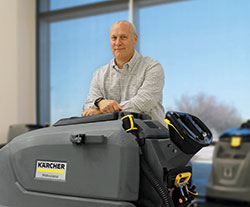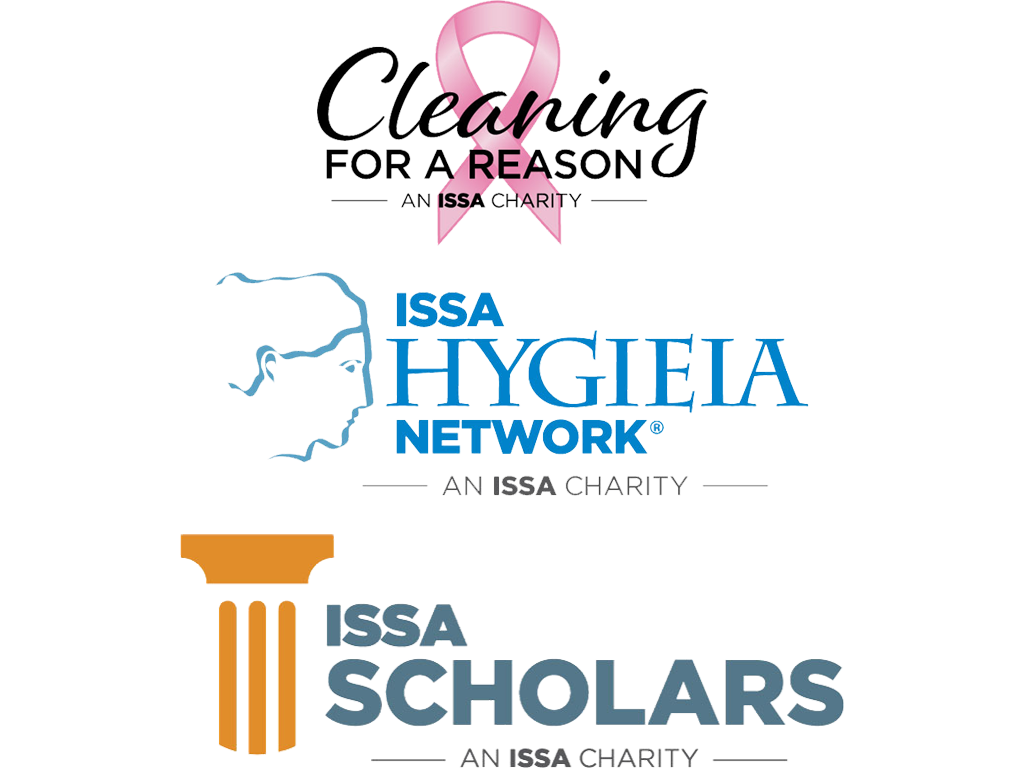Articles
Leading Innovation Globally
Categories: Innovations, Trends & Technology, Member Profiles
By Graeme Golucki | June 14, 2019 << Back to Articles
Accessible by: anyone
Alfred Kärcher GmbH & Co. KG has been at the forefront of high-pressure cleaning technology for decades. The company’s founder, inventor Alfred Kärcher, originally went into business developing industrial submersible heating elements. But in the 1950s, Kärcher’s company shifted its focus to the cleaning industry, releasing what was the first European hot water high-pressure cleaner. By the 1960s, the company had expanded through Europe, and by the following decade it maintained a global presence.
Today Kärcher North America embodies the creative essence of the company’s namesake. In 2018 Kärcher received the ISSA Innovation Award in the equipment category for its KIRA B50 Intelligent Cleaning Robot, continuing its streak of revolutionary product advancement. The company has been a mainstay of the ISSA Innovation Awards, also winning an award in 2014 for its BR 35/12 C Bp walk-behind compact floor scrubber, and actively participating almost every year since the program’s inception.
“Our founder set the standard for developing a culture of innovation,” said Rex Shull, director of product management for Kärcher North America. “Even after all these years, we’re still refreshing our products and growing our portfolio. Ninety percent of our products were engineered in the last five or six years.”
Establishing value
According to Shull, Kärcher is constantly looking for the next solution for the cleaning industry. “Typically, we find [through our research] that 75% of our product development strategy is market-need driven, and the other 25% is reactionary or based on something we see needs to fill a gap.” Shull said. “For that 75%, we do a tremendous amount of end-user research with nothing more in mind but to figure out our users’ needs and their biggest pain points. Take something like our stand-on products. Our customer research led us to develop that line. We found, through research, standing users were more efficient than those who sat.”
Kärcher has also been quick to adopt and further autonomous technology, something some end-users have been leery of, due to concerns of how it might impact staffing. “We’ve found in studies that more than 90% of facilities simply do not have the resources to efficiently perform the scope of their cleaning tasks,” Shull said. “In addition, stats show a 15-20% call-in rate, leaving an average cleaning crew of 20 employees short two to three people a day. By using autonomous equipment for broader tasks like floor cleaning, the human workers with skill and ability are freed up to do the more detailed sophisticated work that you can’t get out of the robot. We see robots as a product assist, allowing cleaners to do more with less.”
Global presence
With locations in dozens of countries worldwide, Kärcher always has to be mindful of product requirements unique to certain regions, as cleaning processes and mindsets may differ from country to country. “When we’re developing a new piece of equipment, we work to develop common platforms but differentiation in product specifics,” Shull said. “For example, the body of a scrubbing machine is pretty standard. Where it gets tricky in Europe, the squeegees need to operate and turn differently than those in the United States. Also in Europe, plastic heads are 100% acceptable, but when it comes to the United States, users want a cast-aluminum head as it has the perception of durability. Our executive team takes the outlook of designing a product for a platform or market, but developing it for a region.”
Shull also notes that Kärcher takes into account what happens to its products once they’ve been sold, since where they operate can impact or determine the after-market services available. “In the United States and Europe aftermarket, parts and services are extremely important,” Shull said. “But we found as we’ve expanded internationally, the aftermarket needs are completely different depending on location. For example, in China, users tend to service the products themselves.”
Drawing a crowd
As Kärcher was expanding in the 1970s, the company also joined with ISSA, a relationship that has continued to be fruitful for both parties throughout the years. “At Kärcher, we’ve always felt it was vital to be an active participant in the market we’re selling in,” Shull said. “We want to support the cleaning industry, and by being a member of ISSA and exhibiting at its trade shows, we have the opportunity to meet like-minded people and customers. Plus, it helps us keep an eye on the latest trends and our competitors.”
Kärcher’s presence at the ISSA Show has expanded in line with the company’s growth. In recent years, the company has maintained its presence within the bigger booths on the show floor. “It is so much easier to explain how our products work in person, in the booth, versus over a phone call or web conference,” Shull said. “The week of the show is a huge opportunity to get in front of a large amount of people in a short amount of time. And I have to admit—sometimes it’s fun to showcase the big equipment to the crowds.”
In addition to giving Kärcher a platform to showcase its products in action, Shull feels it is critical for the company to maintain an annual presence for other reasons, as well. “Let’s face it, ISSA is the show for the cleaning industry, and when you exhibit, it sends a message that you’re serious about being a part of this business,” Shull said.
Visibility and validation
The launch of the ISSA Innovation Awards Program in 2005 provided Kärcher with another avenue to showcase its innovative products at the ISSA Show. The company has entered a product virtually every year, a trend Shull seeks to continue. “The Innovation Awards are all about increasing our visibility,” he said. “The prepress we receive from ISSA about our entries, even before we get to the show floor, is priceless. It’s all about trying to get consumers familiar with what we’re doing and where we’re headed.”
While getting the word out about new products is important, having a winning entry is an added and much-appreciated bonus for Shull. “Winning an Innovation Award reinforces the fact that we are moving in the right direction and meeting the market’s needs,” he said. “It is validation that our product development is not just innovation for innovation’s sake—that we’re actually accomplishing something that helps the end-user. We invest a lot of money and man-hours designing these products; and while it’s great to get that recognition in an award, the biggest value is we’re getting confirmation that we’re directionally accurate in our development.”
Shull sees founder Alfred Kärcher’s spirit of innovation as a continual guiding force for the company going forward. “Innovation doesn’t have to mean its fancier and more autonomous,” Shull said. “It can also mean simplifying what’s currently done. And it’s not just the obvious product development. We spend a lot of time looking at processes, product delivery, billing, selling, customer service—all of these are pathways that lead to innovation and we look at this all the time. We’ve been able to achieve and maintain our success by constantly examining and questioning what we can improve and delivering these solutions to our customers.”
About the Author.
Graeme Golucki is ISSA's Web Content Manager and can be reached at [email protected]; phone, 800-225-4772 (North America) and 847-982-0800.


